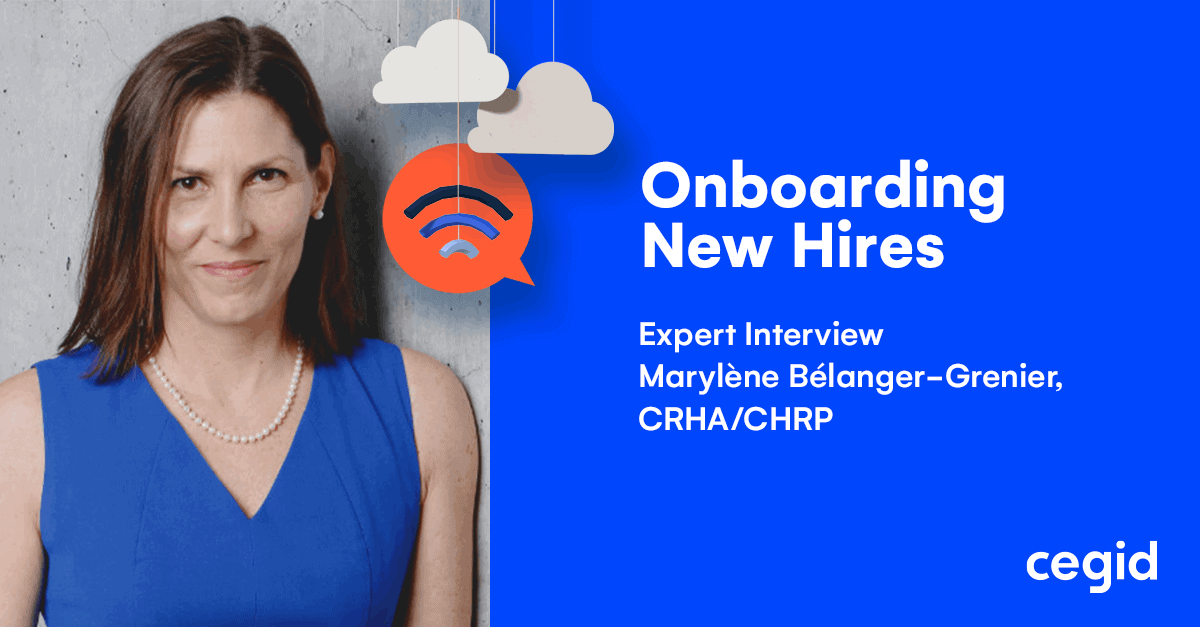Talent Management
Onboarding New Hires – Marylène Bélanger-Grenier, CRHA / CHRP
2 January 2020

According to a recent study by LinkedIn, 22% of all new hires are leaving after the first 45 days. Recruiters and HRDs alike have all been asking the same question: Why? Naturally, this has caused HRDs to refocus their efforts. They must go beyond recruiting top talent and enable new hires to succeed by providing stellar onboarding.
Onboarding allows for transparent communication of procedures, culture and acts as the starting point for employee engagement. Companies with an effective onboarding program can, according to a Glassdoor study conducted in 2019, improve retention by a whopping 82% and productivity by over 70%. With those figures in mind, why is it that the above statistic, courtesy of LinkedIn, is so high? Why do some companies excel while others fail at something as simple as onboarding?
Today, we sat with Marylene Belanger-Grenier, Cegid’s HR Partner responsible for North America, where she shares the importance of a strong onboarding strategy and it’s benefits in delivering the ultimate candidate experience, even after the recruitment process has ended.
C: How important is onboarding in your experience?
MBG: In my opinion, onboarding does not just start on the first day of work. The integration experience begins at the first meeting with a candidate during the recruitment stage. It is important to put the candidate at ease; we want them to want to come back. Once an agreement has been concluded, you must continue to consistently communicate starting on their first day of work. That first day at a new company is decisive for their future. It is important to pay particular attention to the onboarding experience: I believe that every employee must feel unique and important to the company. Employees will always perform better when they feel appreciated and acknowledged.
C: How do you engage employees from the get-go?
MBG: For starters, we shouldn’t recruit employees who simply meet the “job requirements,” we should find people who want to meet the challenges of the job. You can have all the necessary skills on paper but if there isn’t any interest or passion, it may not be a good match. There must be a cohesion between a company’s mission and the candidate’s values. It is important to explain the challenges of the position and be crystal clear on expectations. An employee who feels that there is an inconsistency between the position that has been presented to them and the one they hold will be hard pressed. Alternatively, employees who feel invested with a mission that matches their aspirations, will tend to stay longer and not promote the company to others as well.
C: Do you agree that to retain new hires, one must spend more time onboarding them?
MBG: Absolutely. A successful integration process allows the employee to quickly be at ease in their role. The more attention you pay to the integration, the smoother the integration to the corporate culture will be. As a first step, I do not recommend neglecting the informal aspects of the business. One often underestimates the day-to-day functioning of a work environment. If we take the time to train the new employee on the basic but essential aspects of navigating the new organization (who does what, where to find the supplies, the phone, the coffee, etc.) the more they will feel integrated, making it easier to focus on the essence of their mission. This is also where technology comes into play; for organizations that are rather large, it’s imperative to have tools to guide our new hires into internal networks, content libraries, videos, and self-paced learning support.
C: How does the onboarding process make or break a company?
MBG: Whether you are hiring one person at a time, or ten, we must take the necessary time to integrate each new employee accordingly. Personalization is key. The process must be defined and flexible according to each new hire. If the process is not well planned, done quickly or neglected, we increase our risk of failure and the new hires will feel disappointed: making it more difficult for them to feel included. It takes time to become operational, but that time is highly lying on the company’s side and relies on their onboarding strategy. Onboarding goes beyond simply welcoming the first day; it is a series of activities that allow the employee to develop within the organization. The Onboarding process should span several months or even as long as the first year. Having a longer schedule allows the employee to have a longer-term view of their development. It is the commitment of employees that ultimately ensures the success of a company.
C: What is HR Marketing to you?
MBG: In the context of labor shortages, where it is important to retain our top performing employees and attract the best qualified talent, HR Marketing is crucial. To me, HR marketing is based on the reputation and projected image of a company: this image must be consistent with the spirit and the reality of corporate life. HR Marketing has many faces, from the visual presentation of a company’s career site, to the marketing of job opportunities, programs and value proposition, all the way down to how you engage and establish candidate relationship management throughout the recruitment process. The bottom line is, we must create a powerful candidate experience through employer branding.
C: How does social onboarding influence company culture?
MBG: Social onboarding allows the newcomer to quickly build relationships and build an informal company-wide network. It is important to facilitate networking opportunities from the initial start date. Whether through planned meetings, different services, social activities, team breakfasts, etc. It is this type of initiative that allows employees to build relationships that, in turn, facilitate internal communication. Today, with multiple generations working together, it is important to have tools internally to connect, and increase collaboration. If a company provides such tools, then its easier for people to navigate the system in a language that they speak, which is digital.
C: How does technology help individuals like you in HR towards onboarding new hires?
MBG: Technology makes it possible to automate certain processes needed during onboarding. This allows us to focus our efforts on value-added actions. For instance, through the processes covered by our Talent solutions, Managers and HR actors can ensure a follow-up as close as possible to the expectations related to mobility and training of employees and provide the most appropriate responses. These tools are designed to help Managers and HR actors listen to employee needs in real time and improve their daily commitment and loyalty. Technology tools allow employees to start on the platform and see the team members they work with, who they report to, and what modules they need to learn for the job- at their own pace. Having a library of learning modules makes it easy for everybody while saving time.
Cegid: What are the steps toward successful onboarding?
MBG: I’ll go ahead and list these in point form:
- Develop and monitor a plan and measure its achievement;
- Listen to feedback from new employees / realign the plan according to actual needs;
- Establish clear goals from the start;
C: What is your word of advice to other HR fellows?
MBG: Create an onboarding strategy that starts with a warm welcome and supplement your process with automation. Leveraging digital processes will allow HR teams and hiring managers to collaborate in a central place, to save time and build a great employee experience. Foster relationships through internal community portals so they can interact and develop employees’ skills from the get-go to augment their performance and productivity as well as their confidence. There is nothing more frustrating for a new hire than the feeling of being lost with no guidance.
Marylène Bélanger-Grenier, Member of the Order of Certified Human Resources Advisors has a career spanning nearly 20 years as a generalist in Human Resources Management, primarily in the field of retail and services. During her career, she has been able to develop a variety of skills in the areas of organizational development, employee relations, compensation and benefits and staffing and training. Marylène joined Cegid in September 2018 as an HR Business Partner responsible for North America.
At Cegid, we understand that onboarding is crucial, and we believe that you can help employees grow with great learning tools, while being more efficient and increasing retention through engagement and the ability to measure success.
Cegid offers a complete learning solution that enables organizations to design and deliver the ultimate learning experience all through the ease of the cloud. Harness valuable employee data to develop learning programs that run in parallel with organizational needs. Whatever your learning workflow demands, Cegid’s learning technology is configurable to optimize your system processes and tap into your organization’s full learning potential.


